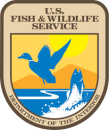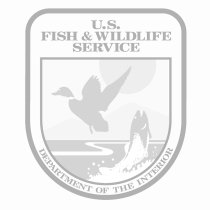Location
States
CaliforniaEcosystem
Desert, LakeIntroduction
The Mohave tui chub (Siphateles bicolor mohavensis = Gila bicolor mohavensis) is a federally listed endangered species, California endangered species, California fully protected species, and the only fish native to the Mojave River. The Mojave River originates in California’s San Bernardino Mountains and flows to the floor of the Mojave Desert, then continues mostly underground to Soda Lake near Mojave National Preserve. The tui chub no longer occurs within the river itself, but exists in natural and man-made refuges, some of which are just outside the course of the river. Mohave Chub Spring (MC Spring) at Soda Springs contains a population of genetically pure fish and is the last natural habitat where they occur. It is thought that the last time MC Spring was connected to the Mojave River was in the early 1900s when the Mojave River flooded and then receded, depositing a small population of fish in the spring. The lands at Soda Springs were managed by the Bureau of Land Management (BLM) and the area surrounding MC Spring was developed in the 1940s by Curtis Howe Springer into Zzyzx Mineral Springs resort. Springer excavated an artificial lake, most likely by enlarging existing springs, and named it Lake Tuendae. At the time of its listing in 1970, tui chubs were found in both MC Spring and Lake Tuendae and the fish occur at both sites to this day thanks to management by the Desert Studies Center, California State University-Fullerton, and the Mojave National Preserve. Mohave tui chub from Lake Tuendae and MC Spring have since served as a source population for historical translocations into 18 locations, most of which have failed to survive. Mojave National Preserve and partners are working to establish and maintain refuges for the fish to promote the species’ recovery using lessons learned from past efforts. Translocations to Morning Star Mine pond and restoration of West Pond at the Preserve represent recent efforts to establish thriving populations of Mohave tui chub.
Key Issues Addressed
When the Mohave tui chub was listed as endangered in 1970, it was near extinction with just four small populations, three of which were introduced populations. Mohave tui chub were historically associated with deep perennial pools (minimum 4 ft depth) with low flow, aquatic plants, and high water quality. Several threats led to their extirpation from the river channel, including predation, competition, and possibly interbreeding with introduced non-native fish in addition to dewatering of the river due to dams, diversions, and groundwater pumping. Currently approximately 18,500 fish exist at Zzyzx and four man-made refuge habitats. The recovery criteria established by the U.S. Fish and Wildlife Service in 1984 require a minimum of six populations of at least 500 fish be established for at least five years and survive one significant flooding event.
Project Goals
- Identify, restore, and maintain habitat for Mohave tui chub translocations to establish additional populations to promote the species’ recovery
- Obtain downlisting from endangered to threatened status
Project Highlights
Stakeholder Workshop: The Preserve hosted a workshop in 2003 in which representatives from government agencies, academia, and the original recovery team came together to review the current status of Mohave the tui chub and to coordinate recovery management.
- Repurposing a Mine Pit: NPS staff surveyed every water source in the Preserve and identified Morning Star Mine pond as a potential translocation site for tui chub. Fisheries biologists from North Dakota State evaluated water quality and habitat characteristics; they concluded that Morning Star Mine was a suitable site for tui chubs based on its size, water permanence, connection to groundwater, and excellent water quality. Translocations occurred in 2011 with 500 tui chub each from Naval Air Weapons Station China Lake and Lake Tuendae.
- Restoring West Pond:West Pond was enlarged by the BLM in the 1980s and stocked with tui chub. Poor water quality, however, precluded their persistence. In 2015, project partners undertook an effort to restore the water quality of West Pond to make it suitable for tui chub. Restoration involved pumping brackish water from the pond and installing a connection from the water supply well to periodically pump fresh water into the pond to maintain low salinity.
- Habitat Maintenance and Monitoring: Periodic vegetation control is required at nearly all man-made ponds to maintain open water. Mark-recapture population monitoring is a requirement for downlisting in the US Fish and Wildlife Service’s Recovery Plan.
- Youth-Engaged Conservation: A population of tui chub was introduced at the Lewis Center for Education Research (the Center) in Apple Valley, California in 2008. High school-aged students at the Center have been involved with hands on monitoring activities including trapping, measuring, and population studies. Additionally, students and youth groups have been involved in monitoring an experimental population of tui chub/arroyo chub that was introduced into a small pond at the Desert Discovery Center in Barstow, California. An aquarium inside the Discovery Center with genetically pure Mohave tui chub allow visitors to understand the story of its survival.
- Stakeholder Workshop: The National Park Service (NPS) hosted a two-day workshop in 2003 to foster cooperation and coordination among the various parties interested in recovery of the Mohave tui chub. Representatives from government agencies, academia, and the original recovery team came together to review the current status of the tui chub, to discuss the potential for down-listing and delisting of the species, and to coordinate recovery management. The NPS produced a 90-page report on the issues and recommendations discussed at the workshop.
Lessons Learned
- Recent translocation efforts are working. As of July 2018, all five populations--Zzyzx, Camp Cady, China Lake, Lewis Center, and Morning Star Mine--have been in existence for more than 5 years.
- Delisting the Mojave tui chub is not currently feasible, but down-listing the fish from endangered to threatened status may be obtainable. One additional population of at least 500 individuals must be successfully established for more than 5 years for downlisting to be considered.
- The water quality restoration at West Pond was successful. Dissolved solids decreased after the pumps were installed, resulting in increased water quality needed to support translocated fish.
- For recovery purposes, the U.S. Fish and Wildlife Service considers all tui chub at Zzyzx--MC Spring, Lake Tuendae, and West Pond--to be one population. Therefore, stocking West Pond would not increase the number of total populations. However, by increasing genetic diversity and numbers of fish, stocking West Pond would increase resiliency of the overall population and provide a buffer in the case of unforeseen events.
- There is very little funding for monitoring and recovery efforts for all Mohave tui chub populations except at Naval Air Weapons Station China Lake. All required monitoring is done by staff as collateral duty and by dedicated volunteers. Maintaining this required monitoring is a challenge with staff turnover.
- There are potential sites for translocations on private lands. However, under current California state law Mohave tui chub is a “fully protected fish” (Fish and Game Code §5515). This law prohibits taking or possessing tui chub, and prohibits California Department of Fish and Wildlife from permitting ‘take’ with few exceptions. This law gives private land owners compelling reasons to not participate in recovery actions. A modification of §5515 to permit incidental take for restoration would facilitate the development of public-private partnerships to establish additional populations of Mohave tui chubs, a criterion for downlisting and eventual recovery.
Next Steps
- Continue to monitor the existing populations and maintain their habitats while locating and restoring potential translocation sites
- Pending USFWS and California Department of Fish and Wildlife approval, translocate fish to restored West Pond
Funding Partner
Restoration of West Pond was supported by a grant from the Desert Fish Habitat Partnership
Resources
- Mojave National Preserve Website
- Garron, K. A. 2006. “Population status of the endangered Mohave tui chub (Siphateles bicolor mohavensis) at Lake Tuendae, Zzyzx, California.” Master's Thesis, California State University, Fullerton, 114 p.
- Lewis Center Information on Mohave Tui Chub Refugia (2012)
- “The Endangered Mohave Tui Chub Has a New Home Courtesy of Ventura FWO and Others.” US Fish and Wildlife Service Field Note (2011)
- Hughson, D., and Woo, D. (2004). “Report on a Workshop to Revisit the Mohave Tui Chub Recovery Plan and a Management Action Plan.”
- 1984 Recovery Plan for the Mohave Tui Chub
- 2009 Mohave Tui Chub (Gila bicolor mohavensis = Siphaletes bicolor mohavensis) 5-Year Review: Summary and Evaluationhttps://ecos.fws.gov/docs/five_year_review/doc2392.pdf
- Integrated Natural Resources Management Plan for Naval Air Weapons Station, China Lake, California
- Naval Air Weapons Station China Lake
- Arizona Cooperative Fish and Wildlife Research Unit
Contacts
- Debra Hughson, Mojave National Preserve, debra_hughson@nps.gov
- Steve Parmenter, California Department of Fish and Wildlife, Steve.Parmenter@wildlife.ca.gov
- Scott Hoffmann, US Fish and Wildlife Service, scott_hoffmann@fws.gov
Case Study Lead Author
Ashlee Simpson, CART Graduate Research Assistant, University of Arizona
Suggested Citation
Simpson, A. C. (2018). “Creating Refuge for Mohave Tui Chub at Mojave National Preserve.” CART. Retrieved from https://www.fws.gov/project/creating-refuge-mohave-tui-chub.









